
-II-

-III-

I recently refined my HDR process to include a few steps in Photoshop, which should hopefully make the colours more tasteful and bring up the contrast, which seems to suffer a lot from the tone-mapping process. So I call the expanded technique 'HDR Redux'.
Needing to make a few trips into Tokyo for camera repairs anyway, I decided to try my hand at some 'true' HDR images, each one made from three photos with different exposures, which I then went on to treat in Photoshop. You can see more of at Tokyo HDR. So, here we go...

Note on HDR Technique: 19/09/2006- In fact, I should come clean- up until now I haven't posted any true HDR images here. The photos I posted earlier are more accurately referred to as 'tone-mapped' photos, as they were made only from one RAW image. In case you don't know, a RAW image comes straight from the camera's sensor, whereas a Jpeg is processed to make it look both smaller and to look good. Of course, one RAW image, being 12-bit, possesses far more information than a conventional 8-bit Jpeg photo, so it is 'relatively' HDR, but it's a contentious issue to call it that.
'True' HDR is pushing back the boundaries of what is possible with digital photography, and dealing with it's nemesis- it's relative lack of dynamic range and sublety of colour, by blending images together to produce 32-bit images, images that can't even be displayed by conventional monitors. Tone-mapping came about as a process for making such images look pleasing to the eye on the screen (though, as I learned, is not always enough on it's own), yet can also be used to bring out the hidden depths of a 12-bit RAW image.
Also, anyone who has read these pages before may notice that there were a lot of the aforementioned 'semi-HDR' tone-mapped images here, that have since been removed. They can still be seen at Tone-Mapping Experiments.
No comments:
Post a Comment